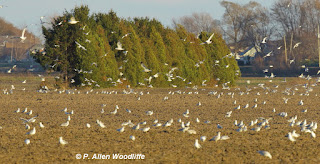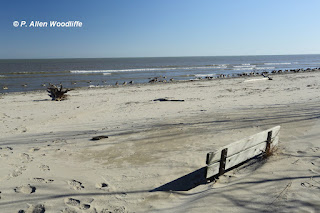Snow Geese are not common in this area. In eastern Ontario, they can number for a few days in the tens of thousands in a single field. Here, we are lucky to see a few individuals each fall. In checking the database of the Blenheim/Rondeau Christmas Bird Count, which has been going for 75 years (and most often between Dec 15-21 so at the very tail end of fall), we've recorded them only about a third of the time, and even then, mostly in numbers less than 10. The blue phase of the Snow Goose is even rarer here. In those same 75 years, we have recorded them on only 7 occasions. So it was a nice treat to see this blue Snow Goose hanging out with several hundred Canada Geese along the east side of Rondeau, which is off limits to hunting and the birds are fairly tolerant.
A juvenile white phase Snow Goose is still in the area, but I didn't get photos of it. It has sometimes been seen along the east beach of Rondeau, but yesterday I saw it with several hundred Canada Geese along the lake shore off of Erieau.
Another mostly snowy white goose is the Ross's Goose which I saw, got decent photos of, and posted about recently. Those two seem to have left the area, as several birders have been diligently looking for them without success.
Right at the beach edge of Rondeau I noted this:
I don't think it will be in high demand for picnicking any time soon, but it might be useful for small kids to put their beach toys on next year. That is if it survives the winter ice, etc.
Sticking with the snowy white bird theme, these large majestic birds are frequently seen, unfortunately in increasing numbers, around Rondeau Bay.
Mute Swans are popular with the general public, but most of the public are not aware (or perhaps don't care) that these birds are some of the most vicious, nasty and damaging species of waterfowl we have to contend with. They really play havoc with almost all of our native species of waterfowl, taking over large areas of wetland and refusing the presence of other species.
Owls are also popular with almost anyone, whether it be a Snowy Owl as shown above, one of the largest of our owls, or the smallest of our owls, the Northern Saw-whet Owl. The Northern Saw-whet is the smallest owl species in Ontario, being only 20 cm (8") although when you see them they usually look even smaller. Just a few days ago one is thought to have flown into a window or something and was sitting in a rather vulnerable place, being threatened by a cat. The landowner brought it to the park. Nothing seemed to be broken, so it was put on a safe branch of a pine tree and left to recover.
A few days ago I purposed to explore part of the Keith McLean Conservation Lands (KMCL), just north of Rondeau, that I had never been to. I was encouraged to do so after having had a conversation with Ken Bell, who had earlier seen one or more very large trees near the far northeastern corner of the property. So I ventured out. En route I crossed a portion of the wetland/creek system that was still free of ice. Some Mallards, Gadwall and this Ruddy Duck were enjoying the respite from the waterfowl hunting going on around Rondeau Bay.
One of the plants that stand out at this time of year is Pokeweed (Phytolacca americana). The dark purplish blue berries against the reddish purple stems are quite obvious. They aren't edible for humans, but birds love them!
I eventually got back to where some big trees were. I came across a Shagbark Hickory that measured 87 cm dbh (dbh is the official height for measuring tree diameter. It is 1.3 metres above the ground which is about 4.5 '). That makes it one of the largest Shagbark Hickories I have ever seen. But larger trees were in store. Near a cluster of woods where some older farm buildings and a residence formerly occurred, I came across this tree that Ken had told me about. It is a Sugar Maple, and measured 125 cm (almost 50") dbh.
And as I gazed across the field towards the wide creek system at the eastern edge of the KMCL, I noted some oak trees that were impressive even from a distance. I had to see them. One of the first Red Oaks I encountered was almost exactly one metre (~40") dbh, but that one was small. One not far away was 155 cm (slightly more than 5') dbh.
 |
| Red Oak, 155 cm dbh |
This one isn't in great shape, but that is typical of trees that have been around for a couple of centuries or more and qualify as old growth specimens. It is hard to tell how old this one is, but is likely at least 200 years old.
Old trees often have hollow sections, which are quite popular with wildlife. When I first saw this raccoon, I thought it was just basking in the sun, but in very short order, I realized it was dead. There has been an outbreak of distemper amongst raccoons this year, which often happens when populations are high, so this individual might have been a victim of that.
As I continued along the top of the creek system, I encountered a real behemoth: this Red Oak, although it was difficult to measure using the exact protocol of the Ontario Forestry Association for the Ontario Honour Roll (OHR) of Trees.
Those standards require measurement at 1.3 m in height from the highest point of land the tree is growing on, which in this case is at the left hand side of the photo. This specimen is on a slope, and measuring at the 1.3 m height means that the large branch on the creek side will interfere with the measurement. So I measured a bit below at about the narrowest diameter, and it came up at about 190 cm (which is almost 6.24 feet across!). It is likely even older than the previously shown one, and it is not impossible for this tree to be ~250-300 years old. It does seem to be in better shape than the 155 cm one, based on outward appearances. I noted afterwards that there were other very large specimens elsewhere along this creek system, perhaps even larger than the ones I've seen already.
This is not the largest Red Oak in Ontario, however. That bit of notoriety is claimed by a specimen growing on private property closer to Blenheim which I measured and proposed to the OHR in 1984 at 194 cm. I intend to get back to measure it again. No doubt it has grown even larger in the 30 years since!


















































